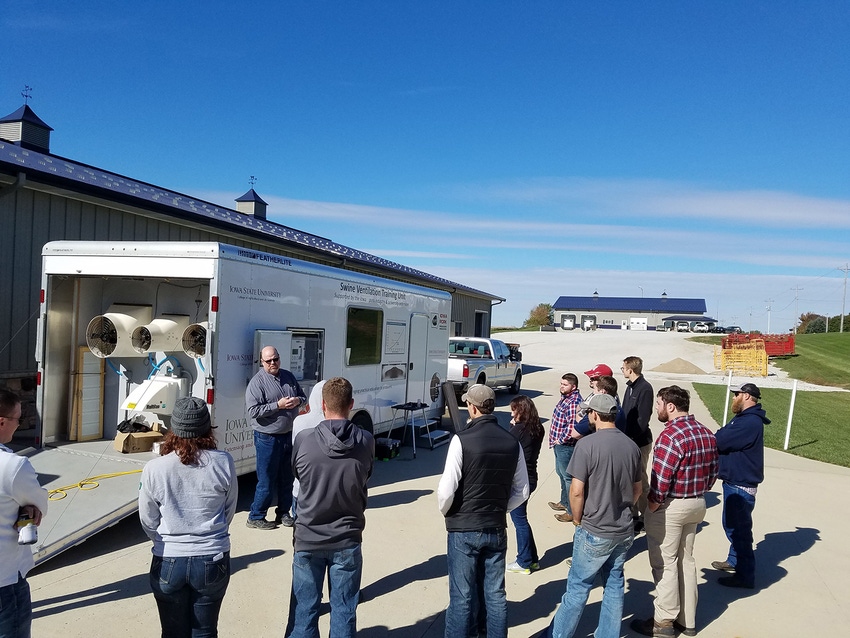Ventilation training is a very important part of overall effective production management. The future should focus on ideas to make training more effective and more accessible to producers.
October 23, 2018

By Jay Harmon and Brett Ramirez, Iowa State University
Managing a ventilation system in a swine barn is a skill that is not innate to most people. People who decide to become swine producers find that it is just one of those necessities that they need to learn as time goes on if they’re going to be successful. Helping swine producers understand ventilation and manage operations effectively has been a long-term goal.
In 2002, Iowa State University, the University of Nebraska, South Dakota State University and the University of Minnesota came together to develop a workshop that used a hands-on demonstration trailer, set-up like a swine building on wheels. Day-long workshops were delivered that afforded hands-on techniques in a biosecure environment. Over the years the program has evolved based on what was learned from producers. The need was great enough in Iowa that we built our own trailer, but the core of the program is still similar.
The training focus we have always tried to maintain is that producers have a great deal of knowledge of their own ventilation systems, but we try to offer a different perspective, expanding their understanding of keys to meeting environmental needs of pigs and of the physics behind ventilation. This both enables and better equips them to dissect and solve existing and new problems. After doing nearly 200 workshops, there are a few observations that we can make.
• Don’t forget to notice the pigs: Producers can recognize an uncomfortable pig and likely know why they may be uncomfortable. It is just important to remember to take time to notice. Undisturbed pigs laying in a pen can offer a lot of insight into their comfort.
• Static pressure usage is a new-ish concept: Producers understand that suction on the door will indicate that there is a negative pressure (vacuum) in their barn. Perhaps less understood is that static pressure is really a report card on inlet management. The goal should be an appropriate level of mixing with air coming out of the inlet between 800 to 1,000 feet per minute and the “right” static pressure will produce the proper speed. High static pressure indicates the inlets are closed too tightly and the fans are starving for air. Low static pressure indicates that inlets are too open (or there are leaks in curtains and other uncontrolled inlets). It is sort of like Goldilocks. Too much or too little is bad. You want it just right.
• Don’t get hung-up on a number: I have been asked “How do I know if I have 2 cubic feet per minute per pig for my minimum ventilation rate?” The idea is that they want to adjust wean-finish ventilation rates to this recommended level so they are not over- or under-ventilating. I tell people that the number is used to select the proper fans during ventilation system designs so it has an appropriate capacity to span the needs of the pig. The actual operating level should be adjusted to give good air quality (ammonia below 25 parts per million) and humidity (below 60%). If the air quality is really good, and you’re using a lot of propane, then you probably are over-ventilating so turn down the rate. If air quality is poor, turn up the ventilation. The actual ventilation rate number doesn’t really matter.
• Change is constant: A minimum ventilation setting will change frequently. As pigs grow they produce more moisture as well as heat, so to maintain a good environment, the minimum rate must change. Estimates can be made on ventilation settings, but the proof is in pig performance and the proper settings will be established from experience with a specific barn.
• Controller training is a challenge: The training unit we have uses one particular controller that was donated to us. It is representative of a class of controllers, but every controller has a different look, feel and logic. Many times producers are frustrated that we are trying to teach them using a controller that does not function like theirs. “General” controller training is not that effective and one-on-one on-farm training might be a better approach. That being said, training of bandwidths and other settings can be discussed but not fully absorbed.
Ventilation training is a very important part of overall effective production management. Our current approach works well, but there are opportunities for improvement. The future should focus on ideas to make training more effective and more accessible to producers.
You May Also Like



